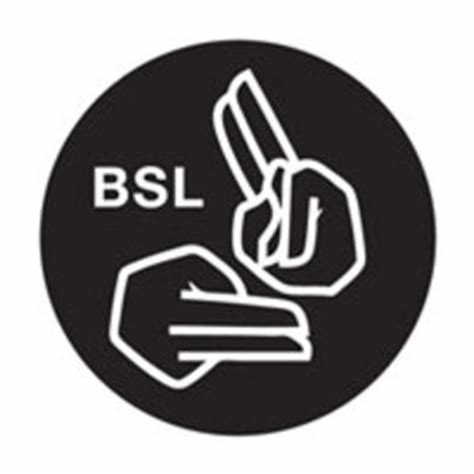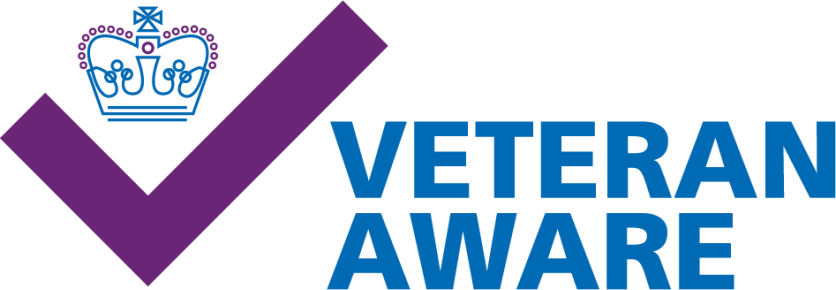Communications and Engagement
Strategy 2022–2025
- Foreword
The Covid-19 pandemic has been a period of uncertainty and complexity. It has highlighted the need for clear messaging, professional communication and the use of multiple communication channels – including digital channels – to ensure that our diverse audiences are informed, engaged and involved in everything we do.
The success of this communication and engagement strategy depends upon recognising the diversity of our communities and stakeholders, listening to them and involving them in the development of our future plans.
This strategy covers a three-year period that is likely to be one of significant challenge and substantial opportunity.
It is designed to ensure that through a combination of professional messaging, service user engagement and effective staff communication we continue to build the Trust’s reputation and standing with all our stakeholders.
This will help us attract and retain staff, inspire public and patient confidence, pave the way for investment and help us become nationally recognised as a leading provider and more locally as a key anchor institution within Lancashire and South Cumbria.
The Communication and Engagement Strategy will set out the Trust’s communication objectives and priorities for the next three years (2022/25) and establishes the communication principles we propose to adopt in seeking to achieve these objectives. This is a strategy not a fully-detailed plan. We are developing individual plans for the delivery of different aspects of the strategy, alongside the refresh of the Big Plan metrics for the next financial year.
Our overarching purpose is to support the delivery of the Trust’s Our Big Plan and the supporting corporate strategies. We will also support the delivery of the New Hospitals Programme communications and engagement strategy. As part of this we need to establish clearly who we need to engage with and how we will best engage with them. We want to expand and develop the conversations we have with staff, patients, families, partner organisations, key stakeholders and our local communities because they are all affected by the work we do and the services we provide.
This document outlines communications to support the Trust ‘corporately’, establishing a common understanding, embedding direction and building culture. This work will mainly be delivered by the communications team and senior leaders, as opposed to operational communications which is role-specific and led by line managers. Communications is everyone’s business and nothing can replace the power or responsibility of line managers to have discussions with their teams and ensure they have the tools and information to do their jobs, but we are here to provide the materials that will make this as easy as possible.
This strategy is designed to underpin our position as the leading healthcare provider in Lancashire and South Cumbria, providing tertiary services across the region and supporting local district general hospitals as the NHS integrates hospital care with community care, primary care and social care. It also aims to contribute to the Trust and wider NHS ambition to improve health outcomes and reduce health inequalities through ensuring our communities are kept updated about and involved in our work. We will successfully achieve this only if our local communities have faith in our reputation and if our staff feel we are a compassionate employer. The work of the communications team is key to this.
This is a living document and will be regularly updated with progress reports coming to Board meetings as requested.

Naomi Duggan
Director of Communications and Engagement - Local Context
Lancashire Teaching Hospitals NHS Foundation Trust was established in 2005 and was the first NHS Trust in the country to achieve “teaching hospital” status. The Trust serves a diverse range of communities and provides high-quality tertiary services to patients in Lancashire and South Cumbria, including Radiotherapy and Specialist Cancer Surgery, Major Trauma, Neurosciences, Plastics & Burns, Renal, Specialist Mobility and Rehabilitation Centre, Vascular and Neonatal Intensive Care. The Trust has a reputation for innovation along with top-quality education, training and research.
This communication and engagement strategy is set in the contextual aftermath of the Our Health Our Care (OHOC) programme which ran for over half a decade until it was formally concluded in 2021 with a definitive ruling from the Secretary of State for Health that the Emergency Department at Chorley and South Ribble Hospital would remain open for 12 hours a day. This decision and our publicly-stated strategic intent to further increase the opening hours at Chorley provided we can do so safely has created the opportunity for a different conversation with the local community and other key stakeholders, particularly our MPs and local councillors.
It also follows on from the launch of the New Hospitals Programme (NHP) which provides us with an important opportunity to look to the future. The NHP will provide a longer-term solution to the limitations of our current estate in providing an optimum experience for colleagues, patients and visitors. The Trust is closely involved in both the strategy development and implementation of this programme which has had, and continues to have, a significant communications and engagement element.
We will utilise the research and intelligence emerging from the programme, including anything which relates to our reputation and we will also develop the contacts made with stakeholders particularly within seldom heard groups. In addition, we will use the opportunity to communicate messages that encourages people to join our Trust Membership scheme.
Of course, it will be many years before any new hospital or new hospital facilities are built and as the NHP does not cover Chorley per se, it is important that we continue to demonstrate investment there alongside the opportunities for Royal Preston Hospital (RPH) – which of course also benefits Chorley residents needing to access specialist care.
The change of strategic focus and narrative at Chorley, as outlined in our Clinical Services Strategy, means that we now have a better opportunity to promote some of our great initiatives there, including the new Birth Centre and the Lancashire Eye Centre.
In addition, the current investment in additional surge capacity, along with plans to remodel our Medical Assessment Unit at Royal Preston are tangible and positive indications that we are making progress towards resolving some of the long-term difficulties in running specialist services, a large Accident and Emergency
Department and the region’s Major Trauma Centre from our outdated estate in the short to medium term. We are clear that further investment is needed in advance of the NHP and our communications and engagement activity will support the case for this.
This communications and engagement strategy is also set in the context of significant changes to the architecture of the NHS with much greater emphasis upon system working and the development of Integrated Care Systems.
While everyone has an important role in the implementation of a Communications and Engagement Strategy, the Chief Executive is central to this. Kevin McGee is well known locally and Chief Executive of the Lancashire and South Cumbria Provider Collaborative Board. This will help ensure the Trust has both influence over and knowledge of the changing NHS landscape and help us can adapt our communications and engagement plans to take these into account.
However, whilst it is essential that we recognise provider collaboration as a key driver for communication and engagement activity, it is also essential that the Lancashire Teaching Hospitals NHS Foundation Trust (LTHTR) maintains and develops its own communications function, corporate identity and reputation. The Director of Communications and Engagement at LTHTR has recently taken on the role as the Senior Responsible Officer for the Provider Collaborative and will work alongside other system Directors of Communications to get this balance right.
The Chair and wider Board also have extensive collective areas of expertise and networks and we need to ensure that we are capitalising on these along with those of the wider leadership team within the organisation.
This strategy is being developed with these contextual points in mind.
- Trust Context
The primary purposes of the Trust’s communication and engagement function are as follows:
- To protect and improve the Trust’s reputation
- To instil a sense of pride about the organisation within our workforce by reflecting the brilliant work they do
- To identify communication threats and opportunities at an early stage and to act/react to them in a timely manner
- To grip and control the communications environment
- To identify who we will engage with and how we will engage with them
- To communicate effectively with the Trust’s many audiences including patients and public, our colleagues and stakeholders
- To use service users’ feedback to improve patient services, patient experience and patient satisfaction
- To develop increasingly inclusive language and imagery
The Trust communication function will employ specialists who have the following skills, capabilities and understandings and/or who can provide the following service components/deliverables:
General
- Applying and embedding the appropriate communication values/principles/ethics
- Communicating patient experience/quality/safety/sustainability
- A full understanding of openness, transparency and candour
- A full understanding of all the tools, channels and methods of communication
- The implications of whistleblowing
- The need for communications to support business/corporate objectives
- The recognition that everyone has a responsibility in the field of communication
- Partnership working with health partners
- Earning a place for communications at the ‘top table’
- Offering strategic counsel
- Developing the necessary suite of professional communication documents
- The shaping and ownership of Trust narratives/values/messages/positioning
- Benchmarking the communications function
- Applying and championing the Lancashire Teaching Hospitals brand and the wider NHS brand including the
- use of our estate to tell our story
The proactive health communication agenda
- Internal staff communications
- Effective external/media communications
- Public engagement and consultation
- Hearing the patient and public voice
- Stakeholder mapping and stakeholder relations
- Media monitoring and evaluation
- Developing effective health campaigns/social marketing
- Relationship building
The reactive health communication agenda
- Crisis/issues management
- Reputation management
- Coaching and support for ambassadors, champions and spokespeople
- Policy developments and their communication
- Communicating health in the digital world
- The 24-hour media and social media
- Websites and intranets
- Infographics and data visualisation
- Data mining and data knowledge
- Innovation in communication
- Branding and marketing
- Stakeholder Engagement
Stakeholder mapping
The map on the next page provides an indicative way of displaying the position of LTHTR’s key stakeholders in relation to their level of influence and interest on particular issues. Of course, stakeholders can move positions or appear in more than one category based on the subject and their involvement amongst other factors.
It is based on guidance in ‘Transforming Participation in Health and Care’ (NHS England), stakeholder analysis from the NHS Institute for Innovation and Improvement and the NHS Constitution.
Our stakeholders can be identified on the basis of ‘9 Cs’ model (some examples have been given but are not an exhaustive list – stakeholders can appear in more than one category):
- Commissioners: those that commission the organisation to do things (NHSE/I)
- Customers: those that receive and use the organisation’s services and their representatives (patients, relatives, carers, Healthwatch)
- Collaborators: those with whom the organisation works to develop and deliver services (other trusts, private sector)
- Contributors: those from whom the organisation receives support for the delivery of services (private sector)
- Channels: those who provide the organisation with a route to service users (third sector)
- Commentators: those whose opinions of the organisation are heard by staff, service users and others (media, MPs, councillors, our own colleagues)
- Consumers: those (beyond customers) who are served by the organisation: i.e. families, carers, relatives etc
- Champions: those who believe in and will actively promote the organisation (our membership, our colleagues, our partners, our patients)
- Competitors: those working in the same area who offer similar or alternative services (private sector and to an extent other trusts)
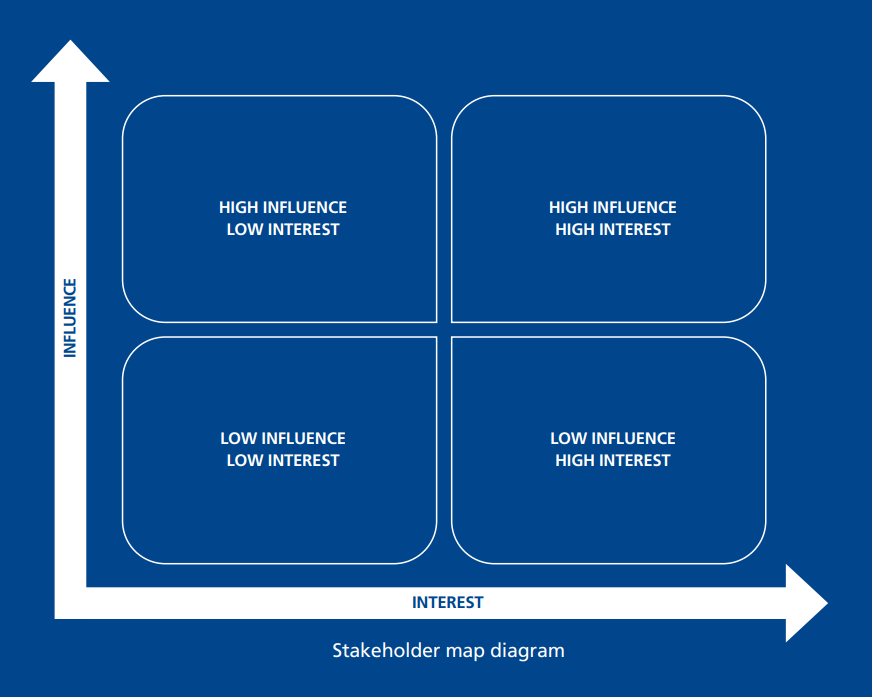
The aim of the stakeholder map is to better understand key stakeholders.
Understanding of stakeholders is guided by the following prompts outlined by NHS England and Improvement (NHSE/I) in its ‘Quality, Service Improvement and Redesign Tools’ document.
- What financial or emotional interest do they have in the outcome of your work? Is it positive or negative?
- What motivates them most?
- What information do they want from you?
- How do they want to receive information from you? What is the best way of communicating your message to them?
- What is their current opinion of your work? Is it based on accurate information?
- Who influences their opinions generally and who influences their opinion of you? Do some of these influencers therefore become important stakeholders in their own right?
- We will use the stakeholder map for different communications campaigns to help understand how to best position our messaging on that particular issue.
- Communications Review
This three-year communications and engagement strategy has been developed following a comprehensive, independent communications review which began in April 2021 at which time it was hoped the NHS might be able to move into an extended period of recovery post pandemic. The review was based on inputs from Trust executive directors, non-executive directors, governors, staff, patients and other stakeholders.
The main findings of this review can be summarised as follows:
- During 2021, Trust communication improved significantly. Trust executives now have more confidence in the communication function and seek communications advice
- Interviewees said the Trust’s communication leadership was now “more experienced”, “more proactive”, “mature”, “visible”, “resilient”, “positive” and a “breath of fresh air”
- The Trust has been particularly effective at communicating with key audiences during the coronavirus pandemic. Painful and tragic though the global pandemic has been for many people, it has given the NHS an opportunity to show itself at its best
- The tone of Trust communication is now more authentic and less “corporate”
- Over the past year or so the Trust has done particularly well in communicating with staff
- Innovation is evident. For example, the video recording of staff briefings has enabled many more staff to watch these briefings even if they cannot attend the live events
The review also concluded, however, that the pandemic has been such a major, all-consuming crisis that it has inevitably resulted in the Trust being somewhat reactive and responsive rather than proactive, and that the Trust needed to turn its focus and attention towards improving positive, external communication and especially communication with key stakeholders including local MPs, Councillors and other political players.
One key aspect of improved communication will be the implementation of necessary improvements to both the Trust website and the staff intranet. These improvements are well under way but have been delayed by the need for the team to support wider NHS messaging and activity around the ongoing pandemic.
In response to feedback from the review, the Trust communications team has significantly increased the Trust’s presence in the local regional and national media by proactively seeking opportunities to communicate key messages in relation to the pandemic and the recovery of services and this has been well received by NHSE/I.
The Chairman, Chief Executive and Director of Communications and Engagement are also involved in a proactive dialogue with democratically elected representatives and are in the process of setting up regular meetings to build upon this.
Footnote: The communications review involved interviews and focus group discussions with board members, governors, executives, other staff and patients. We would like to thank all those who gave their time to the reviewers.
As part of the first year of the Strategy we will be working with our Ambassador Forums and Equality Diversity and Inclusion Group to ensure that we do all that we can to ensure we are using inclusive imagery, language and channels.
- Objectives and Alignment
This communications and engagement strategy is an enabling strategy designed to support the delivery of the Trust’s core objectives identified in ‘Our Big Plan’ and the priorities outlined in NHS England’s 2022/23 priorities and operational planning guidance.
The Trust’s core objectives are:
- To provide outstanding healthcare to our local communities
- To offer a range of high-quality services to patients in Lancashire and South Cumbria
- To drive innovation through world class education, training and research
- The key priorities of the most recent operational planning guidance include:
The development of an elective care recovery plan for 2022/23
- Delivering 30% more elective activity by 2024/25 than before the pandemic
- Eliminating waits of over 104 weeks
- Reducing waits of over 78 weeks
- Return the number of cancer patients waiting for longer than 62 days to the level in February 2020
- Increasing diagnostic activity to a minimum of 120% of pre-pandemic levels
- Reducing 12-hour waits in EDs towards zero and no more than 2%
- Minimising handover delays between ambulance and hospital
- Expanding urgent treatment centre (UTC) provision and increasingly moving to a model where UTCs act as the front door of ED
- Supporting the delivery of out-of-hospital models of care through the development of system digital investment plans
Following a Board workshop held on 18 January 2022, the Trust’s key priorities within ‘Our Big Plan’ have been agreed as:
- Pandemic recovery - improving performance in priority metrics
- Remodelling of the emergency pathway
- Always Safety First
We will measure these via our agreed metrics and as an organisation we will know if we have been successful if we move towards the delivery of SOF 2. Communications and engagement will play a key role in keeping our colleagues informed and engaged in understanding the role they can play in helping us to achieve this.
As an organisation we also have the ambition to move to an overall CQC rating of good, however this may not be possible until the above priorities have been implemented in a sustained way.
Examples of the primary objectives of this strategy are detailed in these tables. Each of the objectives supports at least one or more of the Trust’s ambitions and/or the wider NHS and ICP/ICS priorities.
Objective
- To maintain positive and effective communications with Trust colleagues.
- Ambition: A Great place to Work
- To ensure that positive messages about the Trust are not simply communicated once but are embedded as part of the Trust’s ongoing (repeated) narrative.
- Ambition: Consistently Deliver Excellent Care
- To establish a strong physical/visual communications presence (e.g. large scale TV screens) at key locations around the Trust to help reinforce key messages.
- Ambition: Consistently Deliver Excellent Care
- To establish stronger online strategy including an improvised website, an improved colleague intranet and a dynamic social media programme.
- Ambition: Deliver Value for Money
- To develop a robust system for capturing and communicating a regular flow of positive news that demonstrates what the Trust is good at and showcases the caring nature of its staff.
- Ambition: Fit for the Future
- To ensure the trust communications function supports the Trust’s recruitment activities.
- Ambition: Fit for the Future
- To improve communication and engagement with key external stakeholders and particularly with local, regional and national political stakeholders.
- NHS Ambition
- To develop an updateable Trust narrative (for approval by the Trust board) that captures the main features of the Trust’s strategy and story.
- NHS Ambition
- Communication Aims and Principles
This strategy addresses our fundamental, Trust-wide communication aims which are:
- To keep patients and public, staff and stakeholders informed about the Trust’s activities
- To ensure staff are listened to, engaged, and feel valued
- To be open and transparent with our various audiences and to use their feedback to improve communications
To achieve these aims we will follow the following communication principles:
- We will value compassionate communication that is consistent with our Trust values
- We will be open and transparent about how the Trust is performing and observe our duty of candour
- We will follow the principles of the NHS Constitution, ensuring people can exercise their right to have their say on current and future NHS services
- We will work to meet the communication needs of diverse and hard-to-reach groups, and ensure their voice is heard
- We will seek to use valued and trusted messengers (e.g. senior clinicians) as much as possible We will seek to educate our various audiences about developments and directions of travel in modern healthcare
We will seek to adopt a style in our written materials that is:
- Clear and to-the-point
- Concise and succinct
- Easy to comprehend
- Jargon free and expressed in plain language
- Available in different languages, as appropriate
- Inclusive (this also applies to imagery and the channels we use)
- Our Trust Values
At Lancashire Teaching Hospitals our values set out the behaviours we expect our staff to demonstrate. They are at the very heart of what we do and define us both as individuals and as an organisation. Our public and internal communications will reflect our values and will be delivered with professionalism, integrity, compassion, empathy and understanding. Our communications activity should reflect these.
- Being Caring and Compassionate: Being caring and compassionate is at the heart of everything we do, we will understand what each person needs and strive to make a positive difference in whatever way we can.
- Recognising Individuality: We appreciate differences, making staff and patients feel respected and valued.
- Seeking to Involve: We will actively get involved and encourage others to contribute and share their ideas, information, knowledge and skills in order to provide a joined up service.
- Building Team Spirit: We will work together as one team with shared goals doing what it takes to provide the best possible service.
- Taking Personal Responsibility: We are each accountable for achieving improvements to obtain the highest standards of care in the most professional way, resulting in a service we can all be proud of.
- Our Big Plan Strategy
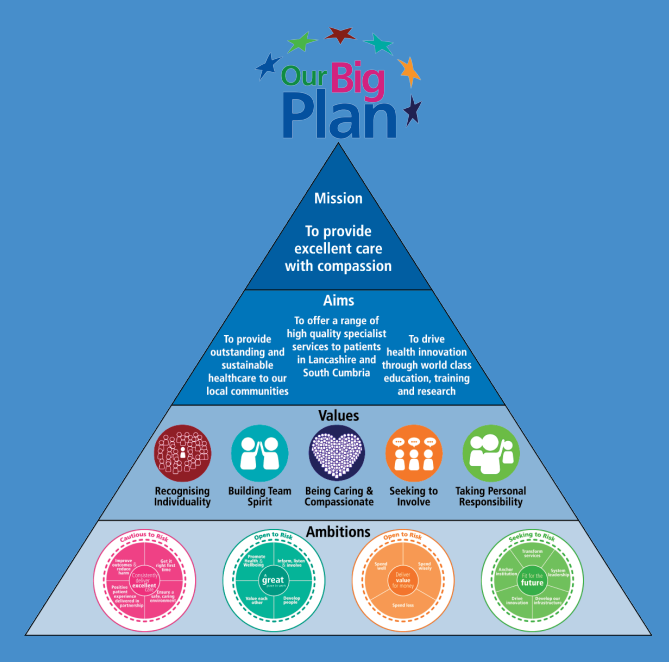
- Timeframe
This strategy will be implemented in three phases. We do not propose to address every issue in year one. In summary terms the strategy will develop as follows:
Phase One (2022/23) - “Getting the Basics Right”
The priorities in Phase One will be a continued focus on positive internal and external communications; improving our relationships and communication with key stakeholders and ensuring an effective working relationship with professional communication colleagues across the local system as we move towards the full development of Integrated Care Systems in July 2022 and into a recovery phase.
Phase One will also involve the development of a clear Service Level Agreement to ensure there is clarity around what is in scope for the communications team (including the mechanisms that will be used); what is out of scope and lead in times for activity – this will be particularly important if the workload continues to grow but there are no additional resources available. We also need to revisit our policies post pandemic to assess if they are fit for purpose.
We will also focus on improvements to the look and feel of our estate through the use of more strategically placed information so that colleagues who do not have easy access to digital communications know where to look for information.
We will continue to play a key role in driving forward the New Hospitals Programme communications and engagement strategy which will be key to the success of the programme.
Overall NHS Communications and Engagement functions have no agreed metrics at a national level although specific projects such as the NHP programme are subject to a number of gateways assessed by NHSE. We will therefore look to work with other communications teams and external organisations to develop a meaningful dashboard.
Phase Two (2023/24) - “Completing the Picture”
In this phase we aim move to develop a number of specialist communication sub-strategies such as communication with our diverse communities and communication through region, place and neighbourhood aligning with and building upon the work of the New Hospitals Programme and the work of our own system Place Based Teams.
Phase Three (2024/25) - “From Good to Best”
In Phase Three we will bring together all the component parts of the communication function and seek to move our outputs from good practice to best practice both as a provider and as an integral player in the new NHS ICS architecture.
The timescale for successful delivery of these phases is dependent to some extent on the continued requirements to support the national and regional NHS and local system in the communications and engagement work relating to Covid-19 and recovery and as part of the new system architecture. Covid-19 has dominated the workload of the communications team over the last two years meaning that other projects such as the development of the website and intranet have taken longer than otherwise would have been the case.
- Resources
Benchmarking shows that the Trust’s communications and engagement team is small in relation to Trusts of a similar size with similar services and in relation to the numbers of colleagues and populations we serve.
This has been challenging during the pandemic however all team members have risen to the challenge and learned new skills.
Wherever possible the focus has been on doing few things well and delivery of some of the key projects need as the foundation for good communications including the digital projects mentioned earlier. Increasingly system and provider communications teams will seek to carry out some of the more transactional work on a “one off” basis particularly for example in relation to key messaging and campaigns around winter and cancer.
During year one of this strategy (2022/23) we will restructure the team slightly to better align with the work programme and continue to make use of some short-term arrangements with individuals with specific skill sets and experience. We will aim to secure additional funding to help support the delivery of this strategy and supplementary communication plan for example via income generation, or grants that may be available to specific workstreams where we will need to make the case that some of the funding is used for communications.
We will also be looking at developing stronger relationships within the system to explore how we can make better use of system wide marketing campaigns and other resources – e.g. NHSE recently commissioned Healthwatch to undertake work on people’s experiences in A&E to help the region and target public messages more effectively.
Internally we will work more closely with teams who have other marketing or engagement resources or other synergies with our work e.g. recruitment; OD and Blended Learning and the Patient and Public Involvement team to see how we can better align activity to make a bigger impact.
There may also be opportunities to utilise existing CCG communications and engagement resources as part of the Place Based work and increasingly the PCB will be looking at how providers can work together to do things once. This may include some transactional communications although as stated earlier Trusts are likely to wish to also have clear identities.
- Channels
Digital
The Trust’s new digital footprint, which includes a new public-facing website and a new colleague intranet platform, will significantly improve our ability to engage with key stakeholders.
The website, which welcomes over 600,000 visitors and generates around 3.5million pageviews each year, will provide our communities with improved usability, accessibility and up-to-date/accurate information. The new navigation and aesthetic refresh will futureproof the website for several years with a mobile first, desktop second approach matching the latest user habits. Meanwhile the improved content management system will allow administrators to prompt colleagues when pages need updating to ensure content remains up-to-date for our communities.
Meanwhile, the Intranet development will bring with it an ability to reach more colleagues with staff and governors able to log-in from a personal device. The platform will also allow the Trust to send tailored updates to specific groups and audiences while also providing clear metrics on colleague usage. Other new features such as polls and surveys and a detailed dashboard will provide the opportunity for more detailed analytics and reports on the effectiveness of our communication.
Internal Communications
Throughout the COVID-19 pandemic the Trust has worked hard to provide transparency across the organisation and keep colleagues informed of the latest developments via a range of mechanisms.
The Trust issues twice-weekly CEO Communications and a Chief Executive Monday Message via email. Executive Team members also keep staff up-to-date each week via a verbal update on Microsoft Teams which discusses pressures and decisions taken at the weekly Strategic Operational Group (SOG). Equally, an Executive Team Q&A is also run bi-monthly which provide staff with the opportunity to ask questions directly to our senior leaders.
We also understand that there are hard-to-reach colleagues and as such a seasonal edition of the staff magazine Connect is published and distributed to colleagues. Other mechanisms such as posters, digital signage and physical signage also provides the opportunity to connect with hard-to-reach staff.
As the Trust emerges from the pandemic, a review of all relevant internal communications is necessary to ensure messaging is being delivered in the most appropriate format to the right audiences.
Membership Communications
The Trust’s membership is kept up-to-date with a twice-yearly magazine, Trust Matters, which describes the latest news and Governor input from across the Trust. The department is also involved in creating and hosting a yearly Annual Members’ Meeting which provides an overview of the Trust’s position and a look ahead to the future. We are also looking to utilise the Membership’s digital database (26% of members) on a more frequent basis and look at mechanisms to increase the take up of digital communications amongst this audience.
Appendix 1 outlines how Communications will support the Trust’s Membership Strategy in delivering improvements in this area.
Media Relations
It has been well recognised that the Trust has undertaken a large volume of print, digital, radio and TV media throughout the COVID-19 pandemic. The NHS has been in the public eye for over 24 months and the opportunities for coverage have been unprecedented versus pre-pandemic levels.
Over the duration of this Strategy it is important that as public interest reduces, we explore new opportunities for coverage by working closely with departments to identify opportunities to promote Lancashire Teaching Hospitals and the services we provide. This can be achieved through drawing upon the good relationships that have been built both locally and nationally with the media to ensure we reach large audiences with our messages.
Social Media
During 2021/22, the Trust has significantly enhanced its frequency, quality and engagement across its social media channels. For example, Lancashire Teaching Hospitals’ LinkedIn channel has significantly more followers than partners across the ICS. Equally, Facebook has witnessed a 16.7% growth in likes and Twitter net growth has enhanced by 232.2%.
However, there are still lots of opportunities to develop our existing channels whilst considering the use of new channels to reach new audiences. Access to Sprout Social provides the department with key analytics to make informed decisions and a review should be carried out to maintain and enhance brand performance and reputation.
External Relations
As identified in the Communications Review section, it is important that as we move out of the COVID-19 pandemic, focus and attention must turn towards improving positive, external communication and especially communication with key stakeholders including local MPs, Councillors and other political players.
A clear and robust engagement plan will be developed to demonstrate how we intend to leverage the Trust’s key opportunities, such as the New Hospitals Programme, to develop and build relationships with our key stakeholders across the communities we serve.
- Risks
The communications and engagement risks should where possible reflect the corporate risks and those within the corporate strategies so will be developed in line with these.
However there are also some specific key communications risks as outlined below which will be reviewed following a forthcoming Board development discussion on risk appetite.
RISK: The Trust keeps having to divert resources to support overarching NHS initiatives to the detriment of local priorities
Mitigation
- Work more closely as a system to do campaigns once SLA with the organisation to outline team responsibilities and deadlines
- Push regional/national team to provide more of a plan
Risk: The Trust has an ambitious agenda – and limited resources for communications
Mitigation:
- SLA to be developed to outline team responsibilities
- Planned approach to communications as outlined in the strategy
- Develop ways of doing things once as a system where possible
- Encourage teams to bid for /allocate resources to communications as part of their plans
- Some time-limited communications resource available for key projects
Risk: Fatigue due to workload pressures may lead to messages being ignored or rejected
Mitigation:
- Make use of new intranet and website tools to establish what information is being accessed as well as use of soft intelligence
- Work with OD and Gold Star teams to see whether there are other ways of reaching staff who don’t access digital communications
- Establish key places for staff to access written information (need to balance with our green plan agenda)
- Keep using a variety of mechanisms to communicate and engage
- Benchmark with other Trusts/private sector on ways of reaching harder to reach and seldom heard staff
Risk: Vacancies in other areas where we have interdependencies can have an impact on the team’s abilities to achieve their objectives e.g. Corporate Affairs; OD
Mitigation:
- Director of Communications to take a pragmatic approach and work with Executive colleagues to agree priority order of work
- Strong relationships between the Directors
Risk: Confusion due to the amount of change across the system and new language being used to describe different parts of it
Mitigation:
- Director of Communications now PCB SRO
- Core script agreed as part of PBC work
- Structured toolkit with templates to enable line managers to have conversations with their teams under development
- Q&As and glossary will be available
Risk: The size of the team makes it hard to be resilient or offer career/ development opportunities within the discipline
Mitigation:
- Ensure proper communications plans are in place and can be accessed by all on a central shared drive
- Encourage team members to develop on the job and undertake appropriate training
- Measurement and Evaluation
Staff Survey – the communications and engagement team will work closely with the OD team to improve overall take up of the staff survey and to improve some of the key engagement scores below particularly 21 c and d. This metric will be agreed with the OD team.
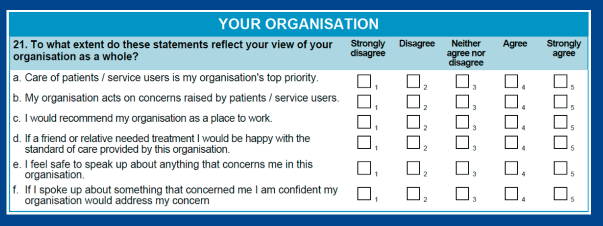
As mentioned earlier, in the absence of any agreed national NHS metrics for communications and engagement, in year 1 the Trust will take part in a pilot with a view to establishing a meaningful dashboard.
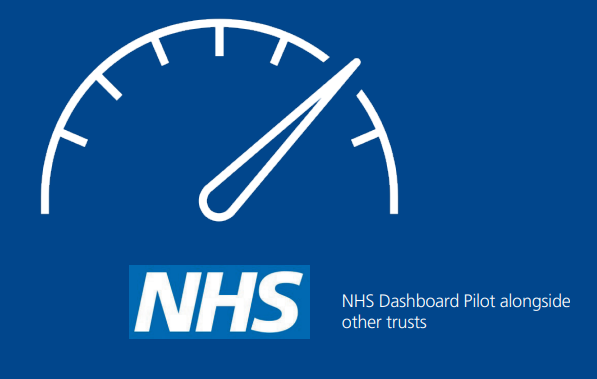
The new website and intranet will allow us to establish better data and set a benchmark in year one which can be used to measure progress in the subsequent years of the strategy.
We will agree the communications and engagement objectives within the other corporate strategies with the strategy owner and then assess whether they have been delivered using both soft intelligence and other agreed metrics.
As the pandemic becomes endemic, we will reassess the media landscape and develop plans to engage the media in other aspects of our work e.g. more focus on education and research, our green plan and sustainability agenda and our role as an anchor institution – it is likely to become far more difficult to get coverage as other issues begin to come to the fore e.g. Brexit; economic recovery; world affairs.
We will continue to work closely with the NHP team and success in terms of that communication and engagement will be measured by the NHSE gateway process as well as soft intelligence from our stakeholders including our governors and membership and feedback through our own internal governance structures.
- Appendix 1: Stakeholder Base
NHS
Staff
- Additional Clinical Services
- Additional Professional, Scientific and Technical
- Administrative and Clerical (including Non-Executive
- Directors)
- Allied Health Professionals
- Board (including Executive Directors and Non-Executive
- Directors)
- Estates and Ancillary
- Foundation Trust Members
- Governors (public, appointed, staff)
- Healthcare Scientists
- Medical and Dental (excluding Lead Employer Doctors)
- Nursing and Midwifery Registered
- Staff side (Trade Unions)
- Temporary staffing/agency /bank /contractors
- Volunteers (650+)
NHS Partners
- Blackpool Teaching Hospitals NHS Foundation Trust
- East Lancashire Hospitals NHS Trust
- GPs/Pharmacies/Social Care settings
- Integrated Care System – Healthier Lancashire & South Cumbria and others
- Lancashire and South Cumbria NHS Foundation Trust
- NHS Chorley and South Ribble CCG
- NHS England/Improvement and NHSE/I North West
- NHS Greater Preston CCG
- North West Air Ambulance and other air ambulance providers
- North West Ambulance Service
- University Hospitals of Morecambe Bay NHSFoundation Trust
NHS Collaborations
- Elective Care Recovery Group
- In and Out-of-hospital Cells
- Integrated Care Partnership
- Lancashire Neurosciences Centre
- Lancashire Pathology Collaboration
- Lancashire Procurement Cluster
- Lancashire Resilience Forum
- New Hospitals Programme
- Provider Collaborative
- System Delivery Boards
- The ICS People Board
- The Lancashire and South Cumbria Cancer Alliance
Networks
Internal
- Communications Directors’ network
- Disabled NHS Directors’ Network
- Finance Directors’ network
- Improvement Directors’ network
- National Flow Coaching Academy network
- Non-Executive Directors’ other networks (to be discussed with Chairman and NEDs and populated)
External
Commissioners/Regulatory bodies such as (but not limited to):
- CQC
- Estates and Facilities contractors
- Go to Doc contractors
- Healthwatch
- HSE
- Midlands and Lancashire Commissioning Support Unit
- NMC, GMC, HCPC and others
- Ofsted
Education/Research
- Bolton University
- Cardinal Newman College/Preston College
- National Institute for Health Research (NIHR)
- Northumbria University
- University of Central Lancashire
- University of Manchester
Charities
- Baby Beat Groups/Networks
- BAME Ambassador Forum
- LGBTQ+
- Living with Disabilities
- Rosemere Cancer Foundation
- Trust Charity
Public bodies, elected officials
Public bodies
- Chorley Council
- Lancashire County Council
- Lancashire Fire and Rescue
- Lancashire Police
- Preston City Council
- South Ribble Borough Council
MPs
- Andrew Stephenson MP (Pendle) – Con
- Antony Higginbotham MP (Burnley) – Con
- Ben Wallace MP (Wyre and Preston North) – Con
- Cat Smith MP (Lancaster and Fleetwood) – Lab
- David Morris MP (Morecambe and Lunesdale) – Con
- Jake Berry MP (Rossendale and Darwen) – Con
- Kate Hollern MP (Blackburn) – Lab
- Katherine Fletcher MP (South Ribble) – Con
- Mark Menzies MP (Fylde) – Con
- Nigel Evans MP (Ribble Valley) – Con
- Paul Maynard MP (Blackpool North and Cleveleys) – Con
- Rosie Cooper MP (West Lancashire) – Lab
- Sara Britcliffe MP (Hyndburn) – Con
- Scott Benton MP (Blackpool South) – Con
- Sir Lindsay Hoyle MP (Chorley) – Ind
- Sir Mark Hendrick MP (Preston) – Lab
Media
Primary media
- Bauer (Rock FM) (radio)
- BBC NW (TV)
- BBC Radio Lancashire (radio)
- Chorley Guardian (print)
- ITV Granada (TV)
- Lancashire Post (print)
- Lancs Live (online)
- That’s Lancashire TV (TV)
Secondary media
- BMJ (trade print and online)
- Business titles, including Lancashire Business View
- Channel 5 (TV)
- HSJ (trade print and online)
- National titles
- Sky (TV)
The public, other groups & demographics
General public
- Campaign groups such as ‘Save Chorley A&E’
- Carers
- Hospital visitors
- Patient groups, Patient Engagement Forums and other
- Patient networks
- Relatives
- Service users
Hard to reach (seldom heard) groups
- Black and ethnic minority groups
- Deprived communities
- Drug users
- Low income groups
- Mental health service users
- Non-English speaking groups
- Offenders, detainees and prisoners
- Older people (particularly those over 80)
- Refugees and asylum seekers
- The hearing impaired
- The homeless and rough sleepers
- The physically disabled
- Those with learning difficulties or disabilities
- Those with nil access to the internet
- Those with sight impairments
- Youth, children and young families
Protected characteristics groups
Groups against whom it is against the law to discriminate as stated in The Equality and Human Rights Commission (and Equality Act 2010)
- Age
- Disability
- Gender reassignment
- Marriage and civil partnership
- Pregnancy and maternity
- Race (BAME)
- Religion or belief
- Sex (male/female)
- Sexual orientation (LGTBQ+)
Patient Experience and Widening Participation
- AccessAble
- Alzheimers.org.uk
- Asian Women’s Forum
- Carers UK
- Deaf Blind UK
- Deafways
- Galloways
- Guide Dogs UK
- Healthwatch
- Hidden Disabilities Sunflower Scheme Ltd.
- Lancashire Carers Service
- Lancashire County Council
- Lancashire Forums of Faith
- NCompass
- PPCV (Public Patient and carers Voice)
- RNIB
- The Blind Society
- Appendix 2: Supporting Trust Strategies
Trust Strategy
Our Big plan
To clearly communicate the Trust’s Objectives and Ambitions and support the agreed priorities, and to do the same with wider Trust strategies as set out below:
Objectives
- To provide outstanding and sustainable healthcare to our local communities
- To offer a range of high quality specialist services to patients in Lancashire and South Cumbria
- To drive health innovation through world class education, training and research
Ambitions
- Consistently deliver excellent care
- A great place to work
- Deliver value for money
- Fit for the future
Supporting Strategies
Ambition: Consistently deliverexcellent care
Always Safety First Strategy
Learning to improve bulletin will develop further to become the Always Safety First Bulletin and be physically displayed throughout key public areas of the organisation demonstrating a transparent approach to learning from safety within the organisation
- Learning from Always Safety First will be evident throughout the organisation, with visual reminders and case studies and teams celebrating the successes of the programmes
- Teams will be supported to gain national recognition for their achievements
This will help underpin the work towards an overall good rating from the CQC along with promoting the work we have done as a Trust to address points raised at the last inspection and celebrating our successes
End of Life Strategy
Ensure the CARING model of End of Life Care at Lancashire Teaching Hospitals is communicated to patients and their loved ones ensuring dignity, respect and compassion
Patient Experience and Involvement Strategy
To communicate to key stakeholders, both internally and externally how we:
- Deliver a positive experience
- Improve outcomes and reduce harm
- Create a good care environment
- Improve capacity and patient flow
Risk Management Strategy
To demonstrate in communication that the:
- organisation’s management understands the risks to which it is exposed
and deals with them in an informed, proactive manner;
- Required risk management practices are an accepted and natural part of the way in which the organisation operates
Mental Health Strategy
To demonstrate through communications how the Trust is meeting the national drivers for change.
To communicate how the Trust is performing against the strategies five commitments within the key strategic priorities.
Ambition: A great place to work
Equality, Diversity and Inclusion Strategy
Communications will support the delivery of the strategy by
- Demonstrating collective commitment to EDI
- Being evidence-led and transparent
- Recognising the importance of lived experience
- Being representative of our communities
- Bringing about change through education and development
- Evolving corporate communications materials and language to become more inclusive
Workforce and Organisational Development Strategy
To support the communication of the Strategy’s strategic primary drivers which include:
- To attract, recruit and resource
- To be inclusive and supportive
- To be well led
- To be responsive and service focused
- To create a positive organisational culture
- To engage and retain
Ambition: Deliver value for money
Finance Strategy
To support the plan by fulfilling duties set out in Appendix A including:
- Finalise slide pack for wider communication of financial strategy internally and externally, set in the context of LTH “Our Big Plan”, values and behaviours
- Programme of communication with Divisions and Support functions
Help communicate our financial challenges in simple terms; why it matters and enlist the support of staff in finding solutions
Ambition: Fit for the future
Clinical Services Strategy
On approval of the Clinical Services Strategy an engaging narrative will be developed for staff, patients and our local population and an engagement programme developed.
- Communicate and engage with external stakeholders
Continuous Improvement Strategy
To communicate how we will use improvement methodology to deliver our ambitious improvement goals and how we will embed this approach across all our services with key priorities of reducing mortality and improving outcomes and providing safe care and reliable care.
Clearly articulate our goals for our improvement programmes.
Digital and Health Informatic Strategy
To support the delivery of the 2020-2025 Digital strategy by highlighting the Digital Hospital initiatives along with ICS and ICP Central Lancashire initiatives.
Support with projects that fall under infrastructure, clinical/operational systems and information.
Education and Training Strategy
To deliver and support education and training for our current and future workforce at Lancashire Teaching Hospitals NHS Foundation Trust (LTHTr).
To extend our education and training offer to healthcare staff locally, regionally, nationally and internationally.
Green Plan
Communicate progress to staff, patients and the wider community.
Embed our approach to sustainability in communications.
Let key stakeholders know how they can contribute to developing and implementing our green agenda.
Support pro-environmental behaviour change and action by harnessing capability, motivation and opportunities.
Research and Innovation Strategy
Strategy pending.
In the meantime the communications team will continue to share success stories via internal and external channels and support the drive for patients and staff to take part in research studies.
Membership Strategy
To ensure membership is representative of the diversity of the population it serves.
To raise awareness amongst foundation trust members of their role and the opportunities available to them.
To ensure that there is regular and effective engagement between members and governors.
To ensure members are kept informed of future plans for the services.
Other initiatives
New Hospitals Programme
We are an active member of Communications and Engagement Oversight Group (CEOG).
- closely involved in communications and engagement strategy development and implementation
- developing and sharing key messages with key stakeholders
- involvement with engagement events and activities
System Wide Working
Sharing key messages from:
- Government/UKHSE
- NHSE/I national and regional
- ICS communications
- CCGs
- Local, regional and national media coverage
CQC preparation
Work with Governance and other colleagues to produce an appropriate range of materials to remind colleagues of the key areas the CQC will be exploring.
Explore how we can improve our communications to reach a wider range of colleagues who do no access digital communications, including through the use of our estate e.g. identified areas to access important information; use of digital screens a more accessible intranet etc.
This Strategy was published in June 2022 and correct at the time of publication.




